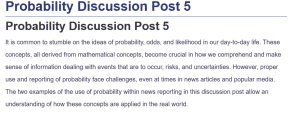Probability Discussion Post 5
It is common to stumble on the ideas of probability, odds, and likelihood in our day-to-day life. These concepts, all derived from mathematical concepts, become crucial in how we comprehend and make sense of information dealing with events that are to occur, risks, and uncertainties. However, proper use and reporting of probability face challenges, even at times in news articles and popular media. The two examples of the use of probability within news reporting in this discussion post allow an understanding of how these concepts are applied in the real world.
Example 1: Asteroid Impact Scenario NASA
Link: https://scitechdaily.com/nasa-confronts-72-asteroid-impact-probability-a-planetary-defense-test/
Our first example is from an article titled “NASA Faces 72% Probability Asteroid Impact: Planetary Defense Test” from SciTech Daily (Jet Propulsion Laboratory, 2024). It considers problems connected with one of the scenarios of NASA’s drill on possible asteroid impacts. The event was an asteroid discovery “that would have an estimated 72% chance of impacting Earth in 14 years”. My interest in considering such a prospect with probability does intrigue me. The article continues to describe the uses of NASA and other agencies in fine-turning approaches to any potential impact threat using these simulations. The figure of 72% probability forms part of a complex situation designed to test participants and challenge decision-making processes under uncertainty. Curiously, an alternative was given in the same article, “a 28% chance that the asteroid will miss Earth,” which takes into account adding up to the mentioned 100% impact probability. It invariably shows an internal consistency within the consideration of the probabilistically based scenario.
Example 2: Gambling and the “Probability Revolution”
The second example is the article titled “How the 18th-century ‘probability revolution’ fueled the casino gambling craze” in The Conversation written by Eglin (2024). It covers a history of the development of probability theory and its application to gambling. This article introduces several concepts of probability, amongst them the law of large numbers and house edge in casino games: “Assuming the wheel strictly aligns with the mean of probability, the house will break even for 18 of 19 spins. But on the 19th spin, the ball will land on one of the green ‘house numbers,’ allowing the house to collect all the money staked from all bettors.” It goes further to discuss how such an understanding of these probabilities led to a change in Gambling practices and regulations. It presents probability as this strong tool that, when well grasped, might have enormous real-world implications.
Reflection on Probability Reporting
These two examples highlight different aspects of the reporting of probability, one using probability to portray the level of risk for a given scenario, while another speaks to how an understanding of probability transformed an industry. Both articles allude to the challenge of appropriately communicating probabilistic concepts to a general audience. The number of probabilities is only one example given by the NASA case, which might sound quite exact to an untrained eye. Besides that, in contrast, the gambling story tries to make those quite abstract probabilistic arguments more substantial, furnishing instances and framing them in a historical context.
By paying close attention to how probability is used and reported, a truer understanding of the information presented is obtained to make better judgments about risks, opportunities, and complex scenarios in our world. As we move through an information environment saturated with statistics and probabilities, developing a critical eye for how these concepts are used will be important. In fact, everything from possible asteroid impacts to the odds on a casino game can be put into perspective using a sound understanding of probability.
References
Eglin, J. (2024, May 24). How the 18th-century “probability revolution” fueled the casino gambling craze. The Conversation. https://theconversation.com/how-the-18th-century-probability-revolution-fueled-the-casino-gambling-craze-228347
Jet Propulsion Laboratory. (2024, August 28). NASA Confronts 72% Asteroid Impact Probability: A Planetary Defense Test. SciTechDaily. https://scitechdaily.com/nasa-confronts-72-asteroid-impact-probability-a-planetary-defense-test/
ORDER A PLAGIARISM-FREE PAPER HERE
We’ll write everything from scratch
Question
Overview: We see the idea of Probability, odds, likelihood, expected outcome, and other predicted values every day. In many cases, the writer or reporter does not have a very good understanding of probability so that the reported values are incorrect. For example, there is no such thing as giving 110% since 100% is everything.
Instructions: Search the news, or online articles and sites to find the term “probability” (likelihood, odds, and expected outcome are also acceptable terms rather than “probability”).. Locate two examples, one where you believe it is used correctly and one that you think seems fishy. Post your sources as a reference. No need to explain the articles, or how the term is used because that will be done in our response later in this module.

Probability Discussion Post 5
Purpose: To help improve your critical thinking skills when it comes to the news and daily events. Not to just accept everything at face value.
Post: Your initial post should contain links to two articles that use the term “probability”. You should find one example where you think the term is used correctly, and one example where you think the person uses it wrong. Do not indicate which example is which, that will be left for your peers in the discussion response at the end of this lesson.

